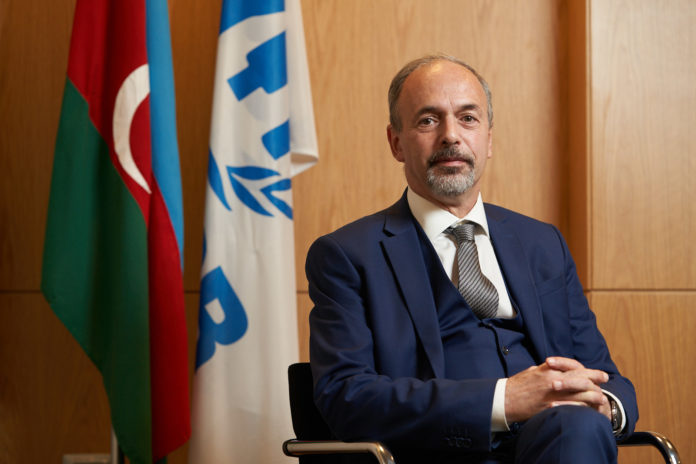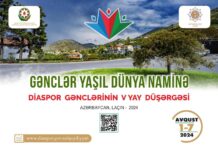The Country Representativeof The United Nations High Commissioner for Refugees (Unhcr) Mr. Guido Ambroso, in an exclusive interview tells Azeri Observer about the main problems which refugees face in Azerbaijan and the gaps in legislation that hinder their solutions. He also explains the difference in UNHCR activity in the country FROM the 1990’s UNTIL THE PRESENT TIME ANDreflects on the roots of migration in the contemporary world.
BY ELENA KOSOLAPOVA
AZERI OBSERVER STAFF WRITER
Question: What are the main missions and goals of the UNHCR in Azerbaijan?
Answer: Our mission, in cooperation with the Government of Azerbaijan, is to protect, find solutions, and, within the limits of our budget, assist three groups of people, refugees, internally displaced persons and stateless persons.
Q.: In the early 1990s, Azerbaijan received around one million refugees from Armenia and internally displaced persons (IDPs) from Nagorno-Karabakh and the surrounding regions. However, these people are still vulnerable. What measures could improve this situation?
A.: First of all, I would like to emphasize that a lot of progress has been made. I was working in Azerbaijan in 1995-1997 with UNHCR. I saw how difficult it was for the IDPs – they lived in train carriages, dugouts, abandoned factories. Luckily, the Azerbaijani government and its people, with the help of the international community, including the UN and UNHCR, have significantly improved the situation for most IDPs. However, as you have indicated, there are still some vulnerabilities. For example, there is high unemployment among some categories of IDPs, particularly those who live near the contact line. (Ed. note: contact line between Azerbaijani and Armenian armed forces.) Besides, there are also some psychosocial issues. Meanwhile, I would like to underline that fortunately we are no longer in an emergency phase. Furthermore, we hope that finally the IDPs will have a chance to return to their original homes on a voluntary basis, in safety but also with dignity.
Q.: Could you tell us about the main projects implemented in Azerbaijan in cooperation with the UNHCR? What positive effect did they have on IDPs?
A.: The projects and strategy that UNHCR carried out in Azerbaijan in the 1990s were quite different from what we are doing now. In the 1990s, the main objective of UNHCR was to respond to the IDPs emergency crisis, and we implemented many important projects. For example, we repaired many big buildings, where the IDPs were living, and provided 11,800 IDPs with newly built limestone houses. In total, some 40,000 IDPs received various types of shelter assistance. We also had projects in water, sanitation and health, along with the generation of income. We estimate that in total, UNHCR spent over $50 million dollars in the 1990s to assist IDPs. We are still engaged with the IDPs, and have some projects for them, but now our main focus is assisting refugees from foreign countries.
Q.: Could you give us an overview of the current migration and asylum context in Azerbaijan? How many refugees and asylum-seekers are there in the country?
A.: UNHCR is not mandated to speak about migration as a whole. There are some people who are migrating purely for economic reasons, and they do not fall within our sphere of responsibility. I can talk only about asylum seekers and refugees. There is a constant influx, which is however, much smaller compared with other countries in Europe and elsewhere in the world. Many countries host hundreds of thousands of refugees; Azerbaijan had to accommodate a huge number of IDPs from Nagorno-Karabakh and the surrounding districts and refugees from Armenia, who were since naturalised. There was one more group that came here in the 1990s – the Meskhetian Turks, who had been deported from Georgia to Central Asia by Stalin, and then expelled again. It is estimated that 50,000 arrived in Azerbaijan in the 1990s and it is very commendable that the Azerbaijani government naturalized them as citizens.
In terms of refugees from other countries, we are talking about 1,127 refugees and 897 asylum-seekers. Over 50 percent of them come from Afghanistan, and they mainly belong to an ethnic and religious Afghani minority, called Hazaras. They do not necessarily flee from the government, but they flee from what we call ‘non-state actors’ like the Taliban, and other extremist groups, and escape not only to Azerbaijan, but also to many other countries. The rest are made up by other various groups. One of them is the Chechen community from the Russian Federation. However, they are not new arrivals, and have been here since the late ‘90s. This group used to be bigger, but now we are talking about less than 400 people, since the majority of them have returned or have gone elsewhere. Finally, we have some refugees from Iran, and other Middle Eastern countries, like Syria or Yemen.
Q.: What problems do refugees and asylum seekers face in Azerbaijan?
A.: First of all, let me emphasize the main difference between IDPs and refugees. IDPs are citizens of the country, while refugees are not; they come from other countries. Many refugees are traumatized; some of them have lost relatives. Language is obviously an issue for integration. However, the main difficulty in Azerbaijan is that the majority of them do not obtain official refugee status. They are tolerated, protected from expulsion to their country of origin, where they might face persecution, to which they are relieved. They are allowed to live here, but they lack many rights, including the right to legal employment and social benefits. Therefore, there are some refugees, such as those from Afghanistan, who came here when they were very young, grew up here, went through the whole Azerbaijani education system, even have a university degree, but are not allowed to work legally. They feel integrated with a strong attachment to Azerbaijan, enjoy positive relationships with Azerbaijani people, but find themselves at the margins of society. So, some of them are naturally frustrated.
The simple fact is that Azerbaijan lacks a law on complementary protection. The country has acceded to the 1951 Convention on refugees and the 1967 protocol on refugees, but does not have a law on complementary protection, which all other members of the Council of Europe have. This law broadens the definition of those in need of international protection. The 1951 Convention assumes that all the refugees are escaping from the persecution of the state and have an individual fear of prosecution. However, many refugees, like the Afghanis, are not escaping from state persecution. They are escaping from generalized violence, civil war, or from non-state actors. So, a law with a broader definition of refugee. Such a law has been drafted in Azerbaijan, but has not yet been adopted. So, we are advocating with the government to change the legislation and pass a new law on refugees, which will create a legal basis of protection for these people. We are also hopeful that refugees will have the right to legal employment.
Q.: What projects do you work on now?
A.: We have a program on financial support for the poor and more vulnerable refugees – we give them monthly financial assistance. If they had the right to work, we could reduce this assistance, because our objective is to make them self-sufficient, and not dependent on international or charity organizations. We also have a health project, since the Azerbaijani health system provides primary health care, although it does not cover secondary and tertiary healthcare services for refugees. So, we have an agreement with a clinic, who examines them and sends them to other medical institutions if required. We also have a project in education. It’s worth mentioning that refugee children, even without a legal status, are allowed to attend primary and secondary education institutions (like Azerbaijani citizens) to the credit of the Azerbaijani government. However, they need help to integrate into the education system. Therefore, we organize Azerbaijani, Russian and English language courses and help them with school uniforms and stationery.
Another important project is legal counselling and legal representation. If asylum-seekers are rejected at the administrative level, we hire lawyers who help them to appeal. We also do a lot of capacity building and training programs for our main counterpart, which is the State Migration Service, with whom we have excellent relations. Finally, we have a community center here in Baku, where refugees can meet and attend some courses. We register all the refugees in our biometric database, and we update this database on an annual basis. So, we know where they live, and if they have any problems, they have access to UNHCR. Finally, we have some projects for IDPs. They are not the same type of projects we had in the 1990s, because as I said, we are no longer in an emergency phase. Now we have a project providing legal assistance for IDPs, which is a project on mitigation and the prevention of gender based violence. Every year we invite celebrity Japanese Optometrist Doctor Akio Kanai, who is a winner of Nansen Award (similar to a Noble Prize) for those who help refugees. He has brought thousands of pairs of eyeglasses for IDPs, free of charge. Finally, we have appropriate cooperation from the government to identify and regularize the situation of stateless persons, assisting them in receiving proper identity documents from the Azerbaijani authorities.
Q.: In your opinion, how can we tackle the root causes of migration and forced displacement, specifically from Africa and the Middle East?
A.: This is a very big and difficult question to answer. Of course, there are some drivers of forced displacement or refugee influx, such as wars, occupation, and massive abuse of human rights. Sometimes it is combined with poverty. However, it is not poverty alone. Therefore, the best way to tackle the root cause would be to spread peace, have a more inclusive and tolerant society and to ensure sustainable development in line with sustainable development goals. However, it is very difficult to achieve. It should also be mentioned, that sometimes the situation in the country of their origin improves and refugees decide to repatriate. The objective of UNHCR is to protect and find solutions for refugees, and normally the solutions are voluntary repatriation or local integration. There is a third option, which is resettlement to third countries, but it works only for very few refugees, normally in poor countries of asylum. Here in Azerbaijan we had only a few cases of voluntary repatriation. So, whenever a refugee out of his or her own free will, wants to go back home, we facilitate the repatriation with funds for travel, reintegration, and where necessary, documentation. There were some important repatriation movements in Africa and elsewhere some time ago, however in recent years there have been more deteriorated than improved situations and the numbers of refugees voluntarily repatriating has also reduced.
Q.: What are your expectations of the first Global Refugee Forum, which will take place in December 17-18 in Geneva?
A.: The Global Refugee Forum is a part of a Global Compact on Refugees, which was affirmed by the UN General Assembly in December 2018. It will be a unique opportunity for the international community to come together and lay the foundations for the implementation of the Global Compact over the longer term. This will be an excellent opportunity for the Government of Azerbaijan to gain visibility for its humanitarian commitment to the plight of refugees in line with the 1951 Refugee Convention, to which the Republic of Azerbaijan is party, as well as the state policy of tolerance and multi-culturalism. We hope that Azerbaijan will make some meaningful pledges to improve the situation of refugees, in particular, adopt the amendments to the legislation to incorporate complementary protection and the right to legal employment. I know that Azerbaijan’s pledges have been discussed at various levels in the Government, including the Cabinet of Ministers, sowe are waiting for the outcome.
Q.: What has been the most emotional moment of your tenure so far?
A.: Just recently, we were celebrating the UN day in the ADA University, and there was a young Afghani lady who delivered a very powerful speech. She lost her family members in a bombing attack, and her story was so emotional that it made everybody cry. Another emotional moment was three months ago during an event on IDPs in the Terter region, together with the Chairman of the State Committee for Refugees and IDPs, Rovshan Rzayev. We had a display of photos of Azerbaijani IDPs, which I took in the 1990s. One gentleman recognized himself in one of these photos. He was involved in a project we did for IDPs, and by coincidence after 25 years we met again. It was a very emotional reunion.
Q.: What do you want to achieve during your assignment term in Baku?
A.: My main objective is to work with the government, improve protection of the refugees and ensure that they receive some kind of legal status, and therefore become self-sufficient and integrate within Azerbaijani society. We should be a voice and act as advocates for these people.



















